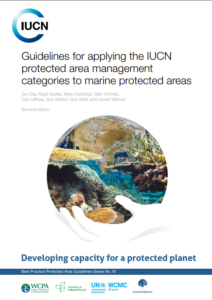International Union for Conservation of Nature (IUCN) launched several guidelines defining which are the protected areas and categorised protected areas through six management types and four governance types, also analyzing which are the features of specific areas that can not be classified as MPAs.
The key difference between MPAs and other areabased measures is that, whatever form the MPAs take, the primary focus is the conservation of biodiversity.
# 6 management types
- Ia Strict nature reserve: Strictly protected for biodiversity and also possibly geological/ geomorphological features, where human visitation, use and impacts are controlled and limited to ensure protection of the conservation values
Ib Wilderness area: Usually large unmodified or slightly modified areas, retaining their natural character and influence, without permanent or significant human habitation, protected and managed to preserve their natural condition - II National park: Large natural or near-natural areas protecting large-scale ecological processes with characteristic species and ecosystems, which also have environmentally and culturally compatible spiritual, scientific, educational, recreational and visitor opportunities
- III Natural monument or feature: Areas set aside to protect a specific natural monument, which can be a landform, sea mount, marine cavern, geological feature such as a cave, or a living feature such as an ancient grove
- IV Habitat/species management area: Areas to protect particular species or habitats, where management reflects this priority. Many will need regular, active interventions to meet the needs of particular species or habitats, but this is not a requirement of the category
- V Protected landscape or seascape: Where the interaction of people and nature over time has produced a distinct character with significant ecological, biological, cultural and scenic value: and where safeguarding the integrity of this interaction is vital to protecting and sustaining the area and its associated nature conservation and other values
- VI Protected areas with sustainable use of natural resources: Areas which conserve ecosystems, together with associated cultural values and traditional natural resource management systems. Generally large, mainly in a natural condition, with a proportion under sustainable natural resource management and where low-level non-industrial natural resource use compatible with nature conservation is seen as one of the main aims

The report highlights that
The benefits to people and coastal communities, and the degree of delivery of conservation outcomes generally increase with the level of protection and effective management, and by a commensurate reduction in the intensity of use and exploitation.
# 4 governance types
- Governance by government: Federal or national ministry/agency in charge; sub-national ministry/agency in charge; government-delegated management (e.g. to NGO)
- Shared governance: Collaborative management (various degrees of influence); joint management (pluralist management board; transboundary management (various levels across international borders)
- Private governance: By individual owner; by non-profit organisations (NGOs, universities, cooperatives); by for-profit organsations (individuals or corporate)
- Governance by indigenous peoples and local communities: Indigenous peoples’ conserved areas and territories; community conserved areas – declared and run by local communities
The report also pays attention to the key features that highlight spatial areas which may incidentally deliver nature conservation but do not have stated nature conservation objectives and should not automatically be classified as MPAs.
Such areas include:
- Fishery management areas with no wider stated conservation aims
- Community areas managed primarily for sustainable extraction of marine products (e.g. coral, fish, shells, etc.)
- Marine and coastal management systems managed primarily for tourism, which also include areas of conservation interest
- Wind farms and oil platforms that incidentally help to build up biodiversity around underwater structures and by excluding fishing and other vessels
- Marine and coastal areas set aside for other purposes but which also have conservation benefit: military training areas or their buffer areas (e.g. exclusion zones); disaster mitigation (e.g. coastal defences that also harbour significant biodiversity); communications cable or pipeline protection areas; shipping lanes, etc.
- Large areas (e.g. regions, provinces, countries) where certain species are protected by law across the entire region
Concluding, to explore more on the revised guidelines, click herebelow
































































